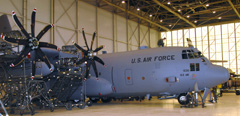
| 418th FLTS Tests
C-130H with NP-2000 Eight Blade Props |
|
|
3/11/2008 - EDWARDS AIR FORCE BASE, CA. -- The 418th Flight Test Squadron here replaced the C-130H Hercules' four-bladed propellers with new eight-bladed NP-2000 propellers Feb. 21 in support of the New York Air National Guard's Operation Deep Freeze mission to Antarctica. The 418th FLTS team started installing the propellers on a Wyoming Air National Guard C-130 in February, while a series of testing will begin in April. "The main purpose of replacing the propellers is to see if we can increase the C-130's take-off performance," said Donna Knighton, 418th FLTS performance and flying qualities engineer. Currently, in addition to the four-blade propellers, the NYANG C-130s are using jet assisted takeoff rockets to get off the ice and snow-covered runways in Antarctica, Ms. Knighton said. The NYANG is providing resupply missions on ski-equipped LC-130s for the National Science Foundation and U.S. Antarctica operations. These one-time use only JATO rockets are strapped to the back of the aircraft to assist takeoffs, said Capt. Grant Mizell, 418th FLTS lead project test pilot. They are very heavy and expensive to use. Aside from changing the propellers, the 418th FLTS also replaced the propeller pitch changing mechanical valve housing with an electrical system to allow the propellers to respond faster, Captain Mizell said. "We chose to use the (WYANG) aircraft because they are better suited for Edwards," he said. "The New York planes are outfitted with skis and other equipment for Antarctica. Once we prove this works, we'll retrofit the (NYANG) C-130." With the new propeller, the testers are anticipating that it will provide more thrust at lower air speeds, and the increase in thrust will be enough to lift the aircraft off the ice, said Capt. Justin Hsia, 418th FLTS engineer. Compared to the current four-blade propellers, which are very heavy and rectangular, the NP-2000 propellers are lighter and shaped in a more aerodynamic fashion, Captain Mizell said. "We will start with stall tests to see if the C-130 is safe to fly," Captain Mizell said. "We will be stalling the aircraft to see if the propellers cause any uncontrollable motion in flight." The second test will be minimum control airspeed tests, where the testers will simulate an engine failure, causing one side of the aircraft to pull more than the other side, Captain Hsia said. The testers will determine if they can still control the aircraft during this situation. "The last test series will determine if our performance increases," Captain Mizell said. "We will be doing numerous takeoffs to see if the new propellers are producing more power, and if it is worth the Air Force's money to upgrade these new propellers." The team will also be doing climb, acceleration, cruise, descent and landing performance tests to characterize the NP2000 performance across the entire aircraft envelope, Ms. Knighton said. The NP2000 propellers were made by Hamilton Sundstrand, while Rolls Royce provided the engine. "This is going to be an extremely exciting flight test," Captain Mizell said. "We are not only going to develop new capability to the Air Force, but we are also going to a place where no one has gone before with this propeller. We are increasing technology, not only for us but on a global scale. Source: USAF/Edwards AFB Press Release by Senior Airman Julius Delos Reyes |
| |
